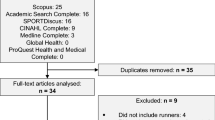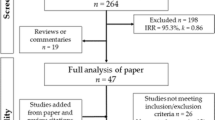Abstract
Background
Oxygen cost of running is largely influenced by endurance training strategies, including interval and continuous training. However, which training method better reduces the oxygen cost remains unknown.
Objective
This study aimed to systematically review the scientific literature and performs a meta-analysis to address the effects of different endurance training modalities on the oxygen cost of running.
Methods
A literature search on 3 databases (MEDLINE, SPORTDiscus and Web of Science) was conducted on February 28, 2019. After analysing 8028 resultant articles, studies were included if they met the following inclusion criteria: (a) studies were randomised controlled trials, (b) studies included trained runners without previous injuries (c) interventions lasted at least 6 weeks, with participants allocated to Interval (INT) or Continuous (CON) groups, and (d) oxygen cost was assessed pre- and post-training intervention. Six studies (seven trials) met the inclusion criteria and were included in the meta-analysis. This resulted in 295 participants (n = 200 INT; n = 95 CON training method). Standardised mean difference with 95% confidence intervals (CI) between INT and CON conditions and effect sizes were calculated. To assess the potential effects of moderator variables (such as, age, VO2max of participants, number of weeks of intervention) on main outcome (oxygen cost of running), subgroup analyses were performed.
Results
Comparing changes from pre- to post-intervention, oxygen cost improved to a greater extent in CON when compared to INT interventions (0.28 [95% CI 0.01, 0.54], Z = 2.05, p = 0.04, I2 = 30%). Oxygen cost improvements were larger in participants with higher VO2max (≥ 52.3 ml kg−1 min−1) (0.39 [95% CI 0.06, 0.72], Z = 2.34, p = 0.02), and in programs greater or equal to 8 weeks (0.35 [95% CI 0.03, 0.67], Z = 2.13, p = 0.03). When the total volume per week of INT was ≥ 23.2 min, there was a significant improvement favorable to CON (0.34 [95% CI 0.01, 0.61], Z = 2.02, p = 0.04).
Conclusion
Continuous training seems, overall, a better strategy than interval training to reduce the oxygen cost in recreational endurance runners. However, oxygen cost reductions are influenced by several variables including the duration of the program, runners’ aerobic capacity, the intervals duration and the volume of interval training per week. Practitioners and coaches should construct training programs that include both endurance training methods shown to be effective in reducing the oxygen cost of running.


Similar content being viewed by others
References
Nummela A, Keränen T, Mikkelsson L. Factors related to top running speed and economy. Int J Sports Med. 2007;28:655–61.
Joyner MJ. Modeling: optimal marathon performance on the basis of physiological factors. J Appl Physiol. 1991;70:683–7.
Saunders PU, Pyne DB, Telford RD, Hawley JA. Factors affecting running economy in trained distance runners. Sports Med. 2004;34(7):465–85.
Santos-Concejero J, Tam N, Granados C, Irazusta J, Bidaurrazaga-Letona I, Zaballa-Lili J, et al. Stride angle as a novel indicator of running economy in well-trained runners. J Strength Cond Res. 2014;28(7):1889–95.
Pate R, Macera C, Bailey S, Bartoli W, Powell K. Physiological, anthropometric, and training correlates of running economy. Med Sci Sports Exerc. 1992;24:1128–33.
Lucia A, Esteve-Lanao J, Oliván J, Gómez-Gallego F, San Juan AF, Santiago C, et al. Physiological characteristics of the best Eritrean runners-exceptional running economy. Appl Physiol Nutr Metab. 2006;31:530–40.
Billat V, Demarle A, Slawinski J, Paiva M, Koralsztein J. Physical and training characteristics of top-class marathon runners. Med Sci Sports Exerc. 2001;33:2089–97.
Enoksen E, Tjelta AR, Tjelta LI. Distribution of training volume and intensity of elite male and female track and marathon runners. Int J Sports Sci Coach. 2011;6:273–93.
Conley DL, Krahenbuhl GS. Running economy and distance running performance of highly trained athletes. Med Sci Sports Exerc. 1980;12:357–60.
Di Pampero PE, Atchou G, Brückner JC, Moia C. The energetics of endurance running. Eur J Appl Physiol Occup Physiol. 1986;55:259–66.
Mayhew JL. Oxygen cost and energy expenditure of running in trained runners. Br J Sports Med. 1977;11(3):116–21.
Bosco C, Montanari G, Ribacchi R, Giovenali P, Latteri F, Iachelli G, Cortili G. Relationship between the efficiency of muscular work during jumping and the energetics of running. Eur J Appl Physiol Occup Physiol. 1987;56(2):138–43.
Krahenbuhl GS, Pangrazi RP. Characteristics associated with running performance in young boys. Med Sci Sports Exerc. 1983;15(6):486–90.
Bransford DR, Howley ET. Oxygen cost of running in trained and untrained men and women. Med Sci Sports Exerc. 1977;9:41–4.
Bergh U, Sjödin B, Forsberg A, Svedenhag J. The relationship between body mass and oxygen uptake during running in humans. Med Sci Sports Exerc. 1991;23(2):205–11.
Santos-Concejero J, Tam N, Granados C, Irazusta J, Bidaurrazaga-Letona I, Zabala-Lili J, Gil SM. Interaction effects of stride angle and strike pattern on running economy. Int J Sports Med. 2014;35(13):1118–23.
Balsalobre-Fernández C, Santos-Concejero J, Grivas GV. Effects of strength training on running economy in highly trained runners: a systematic review with meta-analysis of controlled trials. J Strength Cond Res. 2016;30(8):2361–2368.
Levine BD, Stray-Gundersen J. “Living high-training low”: effect of moderate-altitude acclimatization with low-altitude training on performance. J Appl Physiol. 1997;83(1):102–12.
Barnes KR, Kilding AE. Strategies to improve running economy. Sports Med. 2015;45(1):37–56.
González-Mohíno F, González-Ravé JM, Juárez D, Fernández FA, Barragán Castellanos R, Newton RU. Effects of continuous and interval training on running economy, maximal aerobic speed and gait kinematics in recreational runners. J Strength Cond Res. 2016;30(4):1059–66.
Sjodin B, Jacobs I, Svedenhag J. Changes in onset of blood lactate accumulation (OBLA) and muscle enzymes after training at OBLA. Eur J Appl Physiol. 1982;49(1):45–57.
Franch J, Madsen K, Djurhuus MS, Pedersen PK. Improved running economy following intensified training correlates with reduced ventilatory demands. Med Sci Sports Exerc. 1998;30(8):1250–6.
Billat VL, Flechet B, Petit B, Muriaux G, Koralsztein JP. Interval training at VO2max: effects on aerobic performance and overtraining markers. Med Sci Sports Exerc. 1999;31(1):156–63.
Slawinski J, Demarle A, Koralsztein JP, Billat V. Effect of supra- lactate threshold training on the relationship between mechanical stride descriptors and aerobic energy cost in trained runners. Arch Physiol Biochem. 2001;109(2):110–6.
Barnes KR, Hopkins WG, McGuigan MR, Kilding AE. Effects of different uphill interval-training programs on running economy and performance. Int J Sports Physiol Perform. 2013;8(6):639–47.
Yoshida T, Udo M, Chida M, Ichioka M, Makiguchi K, Yagamuchi T. Specificity of physiological adaptation to endurance training in distance runners and competitive walkers. Eur J Appl Physiol. 1990;61(3–4):197–201.
Smith TP, McNaughton LR, Marshall KJ. Effects of 4-week training using Vmax/Tmax on VO2max and performance in athletes. Med Sci Sports Exerc. 1999;31(6):892–6.
Morgan DW, Martin PE, Krahenbuhl GS. Factors affecting running economy. Sports Med. 1989;7(5):310–30.
Moher D, Liberati A, Tetzlaff J, Altman DG, The PRISMA Group (2009). Preferred reporting items for systematic reviews and meta-analyses: the PRISMA statement. PLoS Med 6(7).
Pauw KD, Roelands B, Cheung SS, De Geus B, Rietjens G, Meeusen R. Guidelines to classify subject groups in sport-science research. Int J Sports Physiol Perform. 2013;8(2):111–22.
Conley D, Krahenbuhl G, Burkett L, Millar AL. Following Steve Scott: physiological changes accompanying training. Phys Sportsmed. 1984;12(1):103–6.
Overend TJ, Paterson DH, Cunningham DA. The effect of interval and continuous training on the aerobic parameters. Can J Appl Sport Sci. 1992;17:129–34.
Lake M, Cavanagh P. Six weeks of training does not change running mechanics or improve running economy. Med Sci Sports Exerc. 1996;28:860–9.
de Morton NA. The PEDro scale is a valid measure of the methodological quality of clinical trials: a demographic study. Aust J Physiother. 2009;55:129–33.
Oxford Centre for Evidence-based Medicine. Levels of evidence. Univ Oxford. 4–5, 2009.
Maher CG, Sherrington C, Herbert RD, Moseley AM, Elkins M. Reliability of the PEDro scale for rating quality of randomized controlled trials. Phys Ther. 2003;83:713–21.
Baz-Valle E, Fontes-Villalba M, Santos-Concejero J. Total number of sets as a training volumen quantification method for muscle hypertrophy: a systematic review. J Strength Cond Res. Post Acceptance: July 30, 2018.
Schoenfeld BJ, Grgic J, Ogborn D, Krieger JW. Strength and hypertrophy adaptations between low-vs. high-load resistance training: a systematic review and meta-analysis. J Strength Cond Res. 2017;31(2):3508–3523.
Liberati A, Altman DG, Tetzlaff J, Mulrow C, Gøtzsche PC, Ioannidis JPA, et al. The PRISMA statement for reporting systematic reviews and meta-analyses of studies that evaluate health care interventions: explanation and elaboration. J Clin Epidemiol. 2009;62:e1000100.
Hopkins WG, Marshall SW, Batterham AM, Hanin J. Progressive statistics for studies in sports medicine and exercise science. Med Sci Sports Exerc. 2009;41:3–12.
Pugliese L, Porcelli S, Vezzoli A, La Torre A, Serpiello FR, Pavei G, et al. Different training modalities improve energy cost and performance in master runners. Front Physiol. 2018;9:21.
Gunnarsson TP, Bangsbo J. The 10-20-30 training concept improves performance and health profile in moderately trained runners. J Appl Physiol. 2012;113(1):16–24.
Gliemann L, Gunnarsson TP, Hellsten Y, Bangsbo J. 10–20-30 training increases performance and lowers blood pressure and VEGF in runners. Scand J Med Sci Sports. 2015;25(5):e479–89.
Schaun GZ, Pinto SS, Silva MR, Dolinski DB, Alberton CL. Whole-body high-intensity interval training induce similar cardiorespiratory adaptations compared with traditional high-intensity interval training and moderate-intensity continuous training in healthy men. J Strength Cond Res. 2018;32(10):2730–42.
Saunders PU, Cox AJ, Hopkins WG, Pyne DB. Physiological measures tracking seasonal changes in peak running speed. Int J Sports Physiol. 2010;5:230–8.
Jones AM, Carter H. The effect of endurance training on parameters of aerobic fitness. Sports Med. 2000;29: 373–386.
Smith TP, Coombes JS, Geraghty DP. Optimising high-intensity treadmill training using the running speed at maximal O(2) uptake and the time for which this can be maintained. Eur J Appl Physiol. 2003;89(3–4):337–43.
Denadai BS, Ortiz MJ, Greco CC, de Mello MT. Interval training at 95% and 100% of the velocity at VO2max: effects on aerobic physiological indexes and running performance. Appl Physiol Nutr Metab. 2006;31:737–43.
Bassett DR, Howley ET. Maximal oxygen uptake: “classical” versus “contemporary” viewpoints. Med Sci Sports Exerc. 1997;29:591–603.
Daniels J, Daniels N. Running economy of elite male and elite female runners. Med Sci Sports Exerc. 1992;24:483–9.
Morgan DW, Daniels JT. Relationship between VO2max and the aerobic demand of running in elite distance runners. Int J Sports Med. 1994;15:426–9.
Lucía A, Hoyos J, Pérez M, Santalla A, Chicharro JL. Inverse relationship between VO2max and economy/efficiency in world-class cyclists. Med Sci Sports Exerc. 2002;34(12):2079–84.
Shaw AJ, Ingham SA, Atkinson G, Folland JP. The correlation between running economy and maximal oxygen uptake: cross-sectional and longitudinal relationships in highly trained distance runners. Plos One. 2015;10(4):e0123101.
Midgley AW, McNaughton LR, Jones AM. Training to enhance the physiological determinants of long-distance running performance. Sports Med. 2007;37(10):857–80.
Denadai BS, de Aguiar RA, de Lima LCR, Greco CC, Caputo F. Explosive training and heavy weight training are effective for improving running economy in endurance athletes: a systematic review and meta-analysis. Sports Med. 2017;47(3):545–54.
Author information
Authors and Affiliations
Corresponding author
Ethics declarations
Funding
No sources of funding were used in the preparation of this article.
Conflict of interest
Fernando González-Mohíno, Jordan Santos-Concejero, Inmaculada Yustres and José María González-Ravé declare that they have no conflicts of interest relevant to the content of this review.
Rights and permissions
About this article
Cite this article
González-Mohíno, F., Santos-Concejero, J., Yustres, I. et al. The Effects of Interval and Continuous Training on the Oxygen Cost of Running in Recreational Runners: A Systematic Review and Meta-analysis. Sports Med 50, 283–294 (2020). https://doi.org/10.1007/s40279-019-01201-x
Published:
Issue Date:
DOI: https://doi.org/10.1007/s40279-019-01201-x




